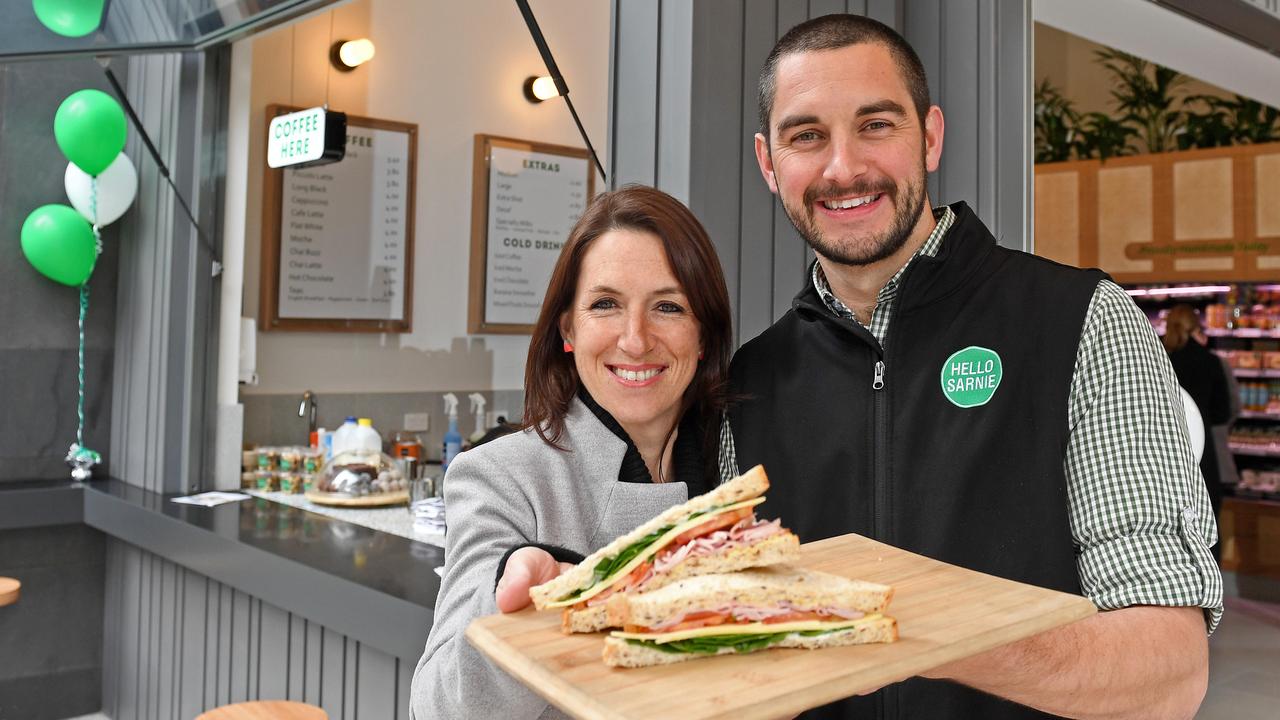Port Adelaide footballer Travis Boak and chef Rocky Oliviera reveals the diet of an AFL player
The days of pies and coke are in the past. Now, AFL players are expected to do everything possible to be in peak condition, and that includes their diet. Port’s club chef reveals what’s on the menu.
delicious SA
Don't miss out on the headlines from delicious SA. Followed categories will be added to My News.
Back in the glory days of the SANFL, when huge crowds packed suburban grounds to watch their heroes play, a certain Port Adelaide rover of the 1970s was legendary for sitting down at half-time with a pie, a can of Coke and a smoke.
Yes, times have changed. As the AFL season kicks off for 2019, football is more professional, the competition more intense, and the players stronger and fitter than ever.
These athletes are expected to do everything possible to be in peak condition, and that includes their diet.
“If you want to be elite, you have to eat elite,” says Rocky Oliveira, a chef who grew up a drop punt from Alberton Oval and has worked with Port’s AFL team since 2017.
“There is no cutting corners anymore, not like in the old days when people used to play professional sport and then drink themselves silly.
“It is so demanding on players, mentally and physically, they have to be in
the best condition possible.”
Former captain and star midfielder Travis Boak agrees.
“I understand my body a lot more now than in my early 20s, when I was probably having a toasted sandwich and Pepsi for lunch most days. Now, I know what my body prefers, what helps it recover and feel better in a game.
“We all train the same and we do the same stuff. It’s the extra that you do outside of that which will help you become a better player. It’s a big part of preparation now.”

RECIPE FOR SUCCESS
Rocky works with the club’s performance dietitian, Emily Hartley, and other members of the high-performance team to convert the nutritional requirements of the modern AFL footballer into delicious, visually appealing food.
These roles are particularly important during the pre-season, when training is at its most intense and players are spending long days at the club.
“Everyone says, ‘What do you do in the off-season?’ – they don’t realise we are still working then,” says Emily.
“In pre-season the main goal is setting strategies for players to fuel and refuel quickly. The sessions are very demanding.
“Their calorie and kilojoule intake will be a lot higher than those people who aren’t exercising.
“On hard training session or on game day it’s really important that players are fuelling themselves with carbohydrates, which is the most readily accessibly fuel. Also protein needs to be boosted to help muscle recovery and muscle development.”
PERSONAL PLANS
While general nutritional guidelines will encompass the entire playing group, individual players will also require their own advice.
“For the younger guys, we need to make sure they get a good distribution of quality protein through the day to build muscle,” Emily says.
“They are often a little on the smaller side when they arrive but in the first few years they start to fill out.”
Players who have been injured or are going through rehab will have different needs, while others may want to work on body composition or rehydration.
“We continually look at their body fat and muscle mass, and from there set targets. I help them maintain and achieve those targets,” says Emily.
For Travis (left) being disciplined with his diet is one of the challenges of the sport.
“The season is a struggle for me because I love food, any sort of food, and maintaining a strict diet isn’t easy,” he says. “I love cakes and Mum bakes these unbelievable sausage rolls. I miss those, and her lamingtons.
“The other thing for me is to try and maintain a steady weight because now I’m 30 and starting to get a little bit sore.”

EARLY LEARNING
Plenty of protein, plenty of carbohydrates, a limited amount of healthy fats. That’s the general formula for players to follow, but how do they adapt it to their daily routines?
Breakfast, says Emily, could be as simple as a bowl of muesli with low-fat milk, yoghurt and fresh fruit, or a smoothie made with similar ingredients.
Travis sticks with muesli and banana when training, or eggs, avocado and brown rice when he has more time.
On Tuesdays during pre-season, Rocky prepares breakfast for the group, who help themselves to a selection including wholemeal toast, shortcut bacon, fried eggs, smashed avocado, oats and fruit. Then they head straight out to the track.
LUNCH TIME
On these tough training days, the first session finishes at about 11.30am. “I make them a protein shake because they need that quickly accessibly recovery food,” Emily says. “It is easy to get down and move on.”
Players then move to a dining room where they can choose from a spread laid out by Rocky and a team of volunteers, who work from early in the morning to feed up to 70 people.
“Everything is as lean and healthy as possible,” Rocky says.
“The boys seem to like it and I think it helps keep them around with a bit more camaraderie and banter, which is better for the club.”
So what’s on the table? Proteins include chicken breast, grilled beef, sliced salmon and ham.
“And we have a lot of vegetables … the guys love their greens,” Rocky says.
Blanched green beans, cauliflower and carrot are always available, while other options might include roasted sweet potato, roasted zucchini and edamame beans. There will also be three salads, such as Asian slaw with soy dressing and crushed peanuts.
A stir-fry will include plenty of veg and a protein such as beef. Rice is brown (or black for using in poke-style bowls, popular over summer).
Turkey rissoles flavoured with fennel and curry powder are thickened with wholemeal breadcrumbs and baked.
“There is no deep frying,” Rocky says. “Vegetables are roasted in a minimal amount of olive oil. We keep everything clean. If the guys see pools of oil they look at it and think, ‘that isn’t good for me’.”
SNACK ATTACK
When the later training session finishes, Emily will hand around a snack containing a good source of carbohydrate, protein and healthy fats “which will help to keep them going”. This might include muesli bars, protein balls or an energy slice.

HOME ALONE
For the evening meal, players are expected to follow similar dietary guidelines at home.
“Dinner, like other meals, needs to be a balance of protein, carbohydrate, plenty of vegies and a little of the good fats to help dampen inflammation,” Emily says.
“It could be a stir-fry with protein and rice. Healthy burgers are good. Fish is great.”
When he is cooking, Travis chooses chicken breast as his main protein, perhaps with sweet potato, brown rice and vegetables.
Emily says it is possible to turn just about any meal into something healthy.
“A lot of the boys love KFC and obviously that isn’t the best for an athlete,” she says. “We have actually worked out a healthy KFC (style) recipe that still has the protein from the chicken and homemade potato chips and plenty of salad. It’s still a balanced meal but something they enjoy.”
To make her “KFC”, Emily prepares a coating of two slices of wholewheat bread, pinch of salt and pepper, two teaspoons each of garlic powder, mustard powder, smoked paprika, dried thyme and dried oregano, as well as a teaspoon of ground ginger, all blitzed in a food processor. Cut a chicken breast into half, dip in beaten egg and then the crumb mix. Bake in a preheated 150C oven for 45 minutes or until golden.
SUPPORT SYSTEM
Players get plenty of help from the club to equip them to eat well and be properly prepared.
Younger players may live with a host family, who take care of dinner preparation. All players who are new to the club, young and old, will take part in sessions on nutrition, cooking classes and shopping tours to help educate them and “provide them with the tools to be elite athletes”, Emily says.
“After a big day on the track, cooking a healthy meal can be the last thing they want to think about,” Emily says. “It’s about equipping them with the skills to make quick healthy meals.
“You want to limit how much temptation there is. Getting the shopping right can help build good habits.”

KITCHEN AID
Travis goes one step further and has Rocky come to his home one to two days each week to prepare a dinner he shares with Sam Powell-Pepper and two other housemates.
Rocky has encouraged Travis to eat fish.
“He started cooking me barramundi with a zesty crumb that is unbelievable,” Travis says. “That is one of my favourite meals now.”
Rocky has also helped ruckman Paddy Ryder as he recovers from an injured cheekbone, dropping him off soup-based meals that he can eat without chewing.
“Some of the younger guys ask for advice as well and I try to figure out ways to help them cook in bulk and … save time.”
GAME ON
Like many other parts of game day preparation, from lucky socks to music choices, meal plans vary from player to player.
“They each have their individual game-day routine and I work with them to make sure that is right,” Emily says.
“Basically, it’s about them arriving to the game well fuelled. They are educated about what is required and then work with their personal preferences.
“For away games, I come up with a hotel menu that they can eat buffet-style.”
Before each home game, Travis will cook his version of pasta bolognese, based on his mum’s recipe but using turkey mince in place of beef mince.
“The white meat doesn’t sit in your stomach as much,” he says. “No one else is allowed in the kitchen – I have to make it myself.”
Players leave two to three hours between a substantial meal and game time. Anything less than that risks stomach upset, particularly if a player is nervous, Emily says.
During the match, players will replace hydration and carbohydrates through sports drinks, gels and powders.
“It needs to be convenient. You don’t really have time to eat a sandwich or something like that,” Emily says.

LIFE LESSONS
Rocky reckons that his time at Port Adelaide has completely changed how he and his wife
eat at home.
“I’m not a professional athlete so I still eat ice cream here and there but I try to cut it back,” he says.
“I’ve tried to cut sugar out of my life totally … I’m having no soft drink, cutting out treats and making better choices.”
Instead of chocolate bars, he eats almonds or jelly.
He eats brown or black rice now, rather than white rice and wholemeal pasta.
He keeps his fridge filled with “stuff that is good for me” such as cooked chicken, ready-made stir-fries, blanched and roasted vegetables, smoked salmon and a choice of dressings “to help spice it up”.
“I have learnt so much about food from the club and the community feeling there is so good,” he says.
“I’m blessed to be part of it.”



